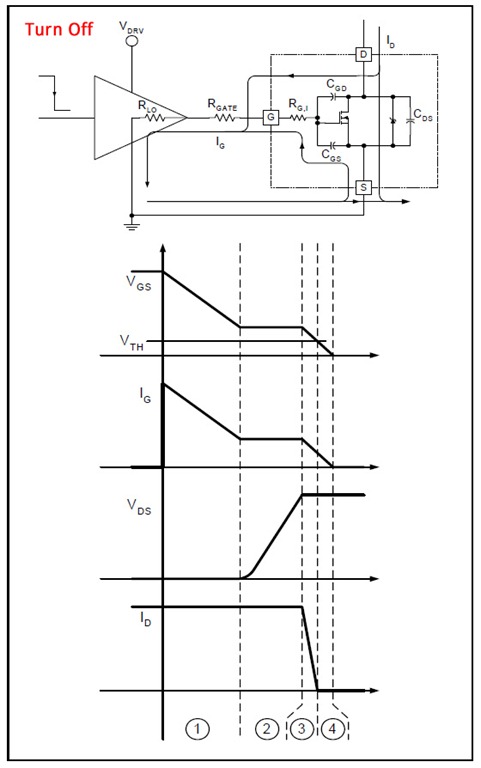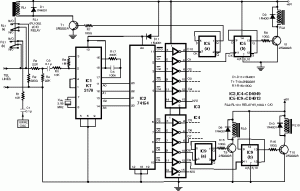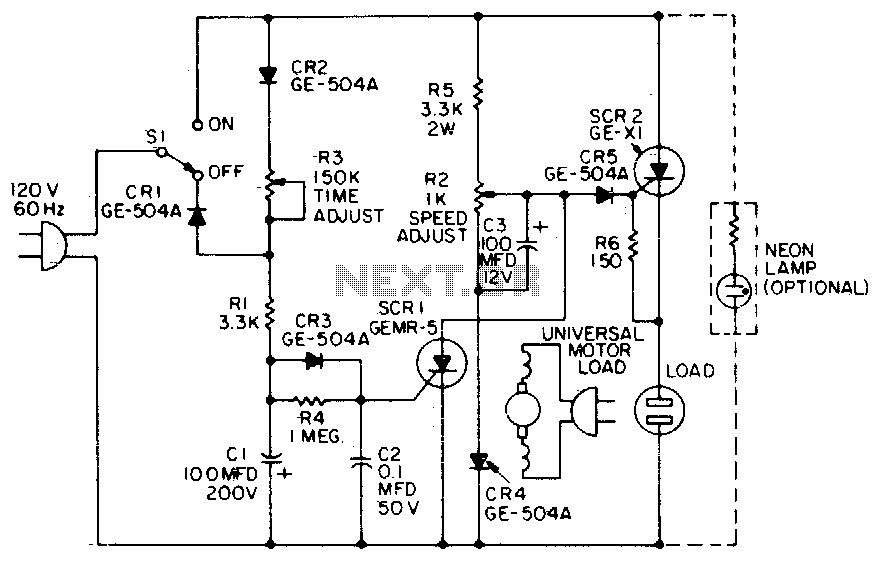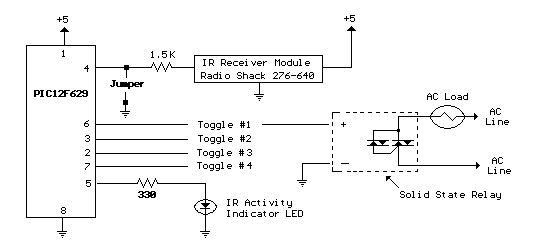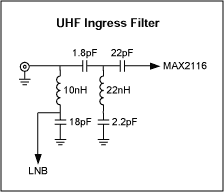
Universal-motor speed control
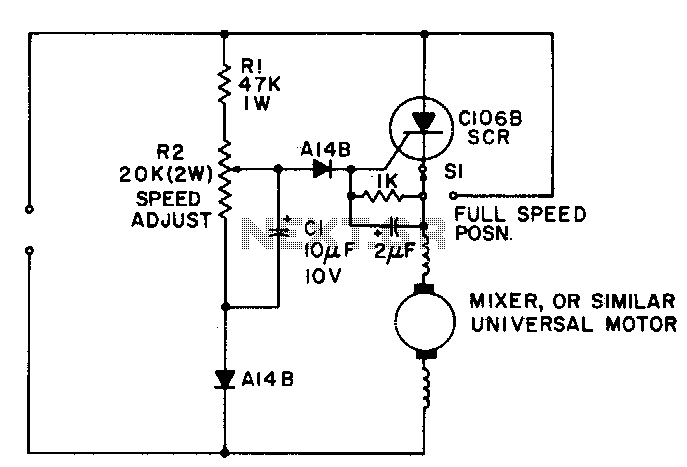
A simple half-wave motor speed control is effective for use with small universal (AC/DC) motors, featuring a maximum current capability of 2 amps RMS. The control provides speed-dependent feedback, ensuring excellent torque characteristics for the motor, even at low rotational speeds. Maximum speed operation can be attained by closing switch Si, which bypasses the SCR.
The half-wave motor speed control circuit is designed to regulate the speed of small universal motors by utilizing a silicon-controlled rectifier (SCR) in conjunction with a feedback mechanism. The SCR allows for the control of the voltage applied to the motor, thereby varying its speed. The circuit operates by allowing only half of the AC waveform to pass through to the motor, which effectively reduces the average voltage supplied to the motor.
In this configuration, the SCR is triggered at a specific phase angle of the AC input waveform, which can be adjusted to control the motor speed. The feedback mechanism is crucial as it monitors the motor's speed and adjusts the triggering angle of the SCR accordingly. This feedback ensures that the motor maintains a consistent torque output, even when operating at lower speeds, which is particularly beneficial for applications requiring precise speed control.
When maximum speed operation is desired, switch Si can be closed. This action creates a bypass around the SCR, allowing the full AC voltage to be applied directly to the motor. This configuration enables the motor to achieve its rated maximum speed without the impedance introduced by the SCR control, making it suitable for applications that require rapid acceleration or full-speed operation.
The circuit components typically include an SCR, a resistor-capacitor (RC) network for timing purposes, and a feedback sensor, which may be a tachometer or other speed-sensing device. The design must ensure that the SCR is capable of handling the maximum current of 2 amps RMS, and sufficient heat dissipation measures should be implemented to prevent overheating during operation.
Overall, this half-wave motor speed control circuit is an effective solution for applications involving small universal motors, providing both speed control and torque maintenance across a wide range of operating conditions.Simple half-wave motor speed control is effective for use with small universal (ac/dc) motors. Maximum current capability 2 amps RMS. Because speed-dependent feedback is provided, the control gives excellent torque characteristics to the motor, even at low rotational speeds Normal operation at maximum speed can be achieved by closing switch Si, thus bypassing the SCR. 🔗 External reference
The half-wave motor speed control circuit is designed to regulate the speed of small universal motors by utilizing a silicon-controlled rectifier (SCR) in conjunction with a feedback mechanism. The SCR allows for the control of the voltage applied to the motor, thereby varying its speed. The circuit operates by allowing only half of the AC waveform to pass through to the motor, which effectively reduces the average voltage supplied to the motor.
In this configuration, the SCR is triggered at a specific phase angle of the AC input waveform, which can be adjusted to control the motor speed. The feedback mechanism is crucial as it monitors the motor's speed and adjusts the triggering angle of the SCR accordingly. This feedback ensures that the motor maintains a consistent torque output, even when operating at lower speeds, which is particularly beneficial for applications requiring precise speed control.
When maximum speed operation is desired, switch Si can be closed. This action creates a bypass around the SCR, allowing the full AC voltage to be applied directly to the motor. This configuration enables the motor to achieve its rated maximum speed without the impedance introduced by the SCR control, making it suitable for applications that require rapid acceleration or full-speed operation.
The circuit components typically include an SCR, a resistor-capacitor (RC) network for timing purposes, and a feedback sensor, which may be a tachometer or other speed-sensing device. The design must ensure that the SCR is capable of handling the maximum current of 2 amps RMS, and sufficient heat dissipation measures should be implemented to prevent overheating during operation.
Overall, this half-wave motor speed control circuit is an effective solution for applications involving small universal motors, providing both speed control and torque maintenance across a wide range of operating conditions.Simple half-wave motor speed control is effective for use with small universal (ac/dc) motors. Maximum current capability 2 amps RMS. Because speed-dependent feedback is provided, the control gives excellent torque characteristics to the motor, even at low rotational speeds Normal operation at maximum speed can be achieved by closing switch Si, thus bypassing the SCR. 🔗 External reference
